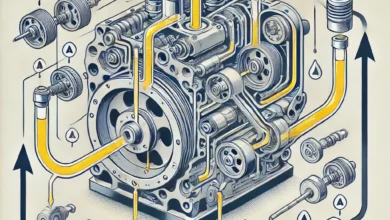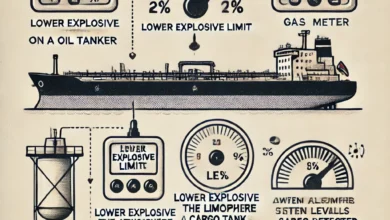What is an Inert Gas System (IGS)?
The Inert Gas System (IGS) is one of the standard protection methods against explosion and fire in cargo tanks, widely used on oil and chemical tankers. It works in a manner such that the atmosphere inside the tanks is maintained as non-flammable, enabling safe operations of loading, unloading, and transit. When in operation, it maintains the oxygen concentration inside the tank low-actually below 8%-which minimizes the chances of explicit reactions with flammable vapors.
Why is an Inert Gas System Important?
Mixtures of flammable vapors and oxygen may form an explosive atmosphere. For most petroleum gases, the flammable range is when the oxygen concentration ranges between 11% and 21%. The Inert Gas System keeps the level of oxygen below 8%, hence the cargo tank atmosphere will always be outside the flammable range. Thus preventing the chances of explosion and fire-a very key factor in making the ship and the crew on it survive.
Key Components of the Inert Gas System (IGS)
- Inert Gas Generator or Exhaust Gas Boiler: The Inert Gas is generated either by taking exhaust gases from the ship’s main engines or independently by a gas generator for this purpose. The generated gas contains very little oxygen and is rich in inert gases like nitrogen and carbon dioxide, hence can be used to create a non-flammable atmosphere in cargo tanks.
- Scrubber Unit: Cool and clean hot exhaust gases by taking out noxious impurities and residual sulfur/carbon particles. This will ensure that the inert gas being supplied to the cargo tanks is innocuous and in no way corrosive or damaging to the tank structure.
- Gas Blowers: Clean inert gas is pumped into the cargo tanks by compressors at controlled pressure. There are several blowers to ensure continuity of supply and to maintain the required pressure in the tanks.
- Pressure and Oxygen Control Valves: Ensure that the flow of the inert gas is regulated, maintaining the pressure and also ensuring that the oxygen level in the cargo tanks does not rise above the safety threshold of 8%.
- Deck Seal:
- Prevent backflow of the gases from the cargo tanks into the engine room or gas generation plant, accordingly, so that the whole system will be safe.
- Distribution piping system:
- Charges the inert gas in equal doses to all cargo tanks for a uniform atmosphere over the total cargo area.
- Pressure-Vacuum (P/V) Breakers: -Guards the cargo tanks against over-pressurization or creation of a vacuum condition within the cargo tanks to an extent that might cause loss of the tank structure.
- Ventilation and Gauging Systems:
- Basics of parameter monitoring involves oxygen, pressure, and temperature inside the cargo tanks to enable safe and efficient operation.
How the Inert Gas System Works: Step-by-Step Process
- **Generation of Inert Gas: Inert gas is generated by IGS through the exhaustion of the ship’s boilers or with a dedicated generator. These gases will naturally have low levels of oxygen and high concentrations of nitrogen and carbon dioxide.
- Cooling and Scrubbing: The hot exhaust gases now pass through a scrubber, where they are sufficiently cooled and cleaned off sulfur and all other injurious impurities, so that the resulting inert gas is innocuous enough to be admitted into the cargo tanks.
- Blowing and Distribution:
Cleaned and cooled inert gas is blown into the cargo tanks through the distribution system. The blowers regulate the flow rate and also maintain a slight positive pressure in the tanks.
- Oxygen Level Control:
Oxygen content of the fed inert gas is always measured in the tanks. This is done in order to keep the oxygen concentration below 8%, which makes the atmosphere inside the tank nonflammable and the risk of explosion irrelevant.
- Pressure Maintenance:
E IGS maintains slight positive pressure in cargo tanks, which prevents the ingress of oxygen-rich air from the external atmosphere, which could lead to the development of a hazardous atmosphere inside the cargo tank.
- Purging and Gas-Freeing:
• After cargo operation manifold execution, the IGS performs purging of the tanks from residual gases and prepares them for inspection, maintenance, or subsequent cargo operations.
Key Benefits of Using an Inert Gas System
- Explosion Prevention:
Emphasized also is the fact that its principal function of the IGS is to prevent explosion and fire by maintaining a nonflammable atmosphere in cargo tanks.
- Tank Integrity Protection:
Before the gas actually enters the cargo tanks, IGS purifies the gas of any dangerous impurities that can cause corrosion and thus deteriorate the structure of the tanks.
- Improved Safety:
- The IGS minimizes the possibility of accidents associated with cargo handling, thereby protecting the crew and vessel from damage by controlling the level of oxygen in the tank and pressure. 4. Cost-Effective Maintenance: – The right application of the IGS system is to decrease the frequency of cleaning and maintenance of tanks, hence reducing the operational cost. Operational Challenges of Inert Gas Systems 1. High Oxygen Levels: If the oxygen content in the inert gas rises above 8%, then it becomes dangerous to create a dangerous atmosphere inside the tanks. This problem is avoided by having regular monitoring and maintenance. 2. **Failure of Sealing Deck: A sill malfunctioning deck seal could leak hazardous gases back into the engine room or gas generator, thus making it a dangerous safety hazard. 3. Low Tank Pressure: A low tank pressure may allow the entry of external air, compromising the safety in the cargo tanks and enhancing the possibility of an explosive atmosphere being developed. #### Conclusion: Inert Gas Systems in Tanker Safety The Inert Gas System is a safety feature on oil and chemical tankers. The IGS works to prevent the explosion of cargo tanks through controlling the oxygen content and the pressure inside the cargo tanks. The inert gas generator, scrubber, gas blowers, and control valves making up the system ensure a stable in-tank non-flammable environment. Whether one is interested in the general working of the Inert Gas System or has specific questions about the various components and their mode of operation, he/she is welcome to ask.


